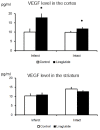Neuroprotective effects of liraglutide for stroke model of rats
- PMID: 24177570
- PMCID: PMC3856019
- DOI: 10.3390/ijms141121513
Neuroprotective effects of liraglutide for stroke model of rats
Abstract
The number of diabetes mellitus (DM) patients is increasing, and stroke is deeply associated with DM. Recently, neuroprotective effects of glucagon-like peptide-1 (GLP-1) are reported. In this study, we explored whether liraglutide, a GLP-1 analogue exerts therapeutic effects on a rat stroke model. Wistar rats received occlusion of the middle cerebral artery for 90 min. At one hour after reperfusion, liraglutide or saline was administered intraperitoneally. Modified Bederson's test was performed at 1 and 24 h and, subsequently, rats were euthanized for histological investigation. Peripheral blood was obtained for measurement of blood glucose level and evaluation of oxidative stress. Brain tissues were collected to evaluate the level of vascular endothelial growth factor (VEGF). The behavioral scores of liraglutide-treated rats were significantly better than those of control rats. Infarct volumes of liraglutide-treated rats at were reduced, compared with those of control rats. The level of derivatives of reactive oxygen metabolite was lower in liraglutide-treated rats. VEGF level of liraglutide-treated rats in the cortex, but not in the striatum significantly increased, compared to that of control rats. In conclusion, this is the first study to demonstrate neuroprotective effects of liraglutide on cerebral ischemia through anti-oxidative effects and VEGF upregulation.
Figures






Similar articles
-
Neuroprotective and anti-apoptotic effects of liraglutide in the rat brain following focal cerebral ischemia.Neuroscience. 2014 Dec 5;281:269-81. doi: 10.1016/j.neuroscience.2014.09.064. Epub 2014 Oct 6. Neuroscience. 2014. PMID: 25301749
-
Delayed Administration of the Glucagon-Like Peptide 1 Analog Liraglutide Promoting Angiogenesis after Focal Cerebral Ischemia in Mice.J Stroke Cerebrovasc Dis. 2018 May;27(5):1318-1325. doi: 10.1016/j.jstrokecerebrovasdis.2017.12.015. Epub 2018 Feb 1. J Stroke Cerebrovasc Dis. 2018. PMID: 29395648
-
Neuroprotection in Rats Following Ischaemia-Reperfusion Injury by GLP-1 Analogues-Liraglutide and Semaglutide.Cardiovasc Drugs Ther. 2019 Dec;33(6):661-667. doi: 10.1007/s10557-019-06915-8. Cardiovasc Drugs Ther. 2019. PMID: 31721014 Free PMC article.
-
A review of efficacy and safety data regarding the use of liraglutide, a once-daily human glucagon-like peptide 1 analogue, in the treatment of type 2 diabetes mellitus.Clin Ther. 2009 Nov;31(11):2472-88. doi: 10.1016/j.clinthera.2009.11.034. Clin Ther. 2009. PMID: 20109994 Review.
-
Liraglutide and its Neuroprotective Properties-Focus on Possible Biochemical Mechanisms in Alzheimer's Disease and Cerebral Ischemic Events.Int J Mol Sci. 2019 Feb 28;20(5):1050. doi: 10.3390/ijms20051050. Int J Mol Sci. 2019. PMID: 30823403 Free PMC article. Review.
Cited by
-
Synergistic therapeutic effects of intracerebral transplantation of human modified bone marrow-derived stromal cells (SB623) and voluntary exercise with running wheel in a rat model of ischemic stroke.Stem Cell Res Ther. 2023 Jan 24;14(1):10. doi: 10.1186/s13287-023-03236-4. Stem Cell Res Ther. 2023. PMID: 36691091 Free PMC article.
-
Neuroprotective Mechanisms of Glucagon-Like Peptide-1-Based Therapies in Ischemic Stroke: An Update Based on Preclinical Research.Front Neurol. 2022 Mar 15;13:844697. doi: 10.3389/fneur.2022.844697. eCollection 2022. Front Neurol. 2022. PMID: 35370875 Free PMC article. Review.
-
Current Trends in Biomaterial Utilization for Cardiopulmonary System Regeneration.Stem Cells Int. 2018 Apr 29;2018:3123961. doi: 10.1155/2018/3123961. eCollection 2018. Stem Cells Int. 2018. PMID: 29853910 Free PMC article. Review.
-
Liraglutide Activates the Nrf2/HO-1 Antioxidant Pathway and Protects Brain Nerve Cells against Cerebral Ischemia in Diabetic Rats.Comput Intell Neurosci. 2018 Feb 12;2018:3094504. doi: 10.1155/2018/3094504. eCollection 2018. Comput Intell Neurosci. 2018. PMID: 29623090 Free PMC article.
-
GLP-1R activation for the treatment of stroke: updating and future perspectives.Rev Endocr Metab Disord. 2014 Sep;15(3):233-42. doi: 10.1007/s11154-014-9285-9. Rev Endocr Metab Disord. 2014. PMID: 24777909
References
-
- Nauck M.A., Meier J.J. Glucagon-like peptide 1 and its derivatives in the treatment of diabetes. Regul. Pept. 2005;128:135–148. - PubMed
-
- Buse J.B., Rosenstock J., Sesti G., Schmidt W.E., Montanya E., Brett J.H., Zychma M., Blonde L. LEAD-6 Study Group. Liraglutide once a day versus exenatide twice a day for type 2 diabetes: A 26-week randomised, parallel-group, multinational, open-label trial (LEAD-6) Lancet. 2009;374:39–47. - PubMed
-
- Holscher C. Potential role of glucagon-like peptide-1 (GLP-1) in neuroprotection. CNS Drugs. 2012;26:871–882. - PubMed
Publication types
MeSH terms
Substances
LinkOut - more resources
Full Text Sources
Other Literature Sources
Medical

